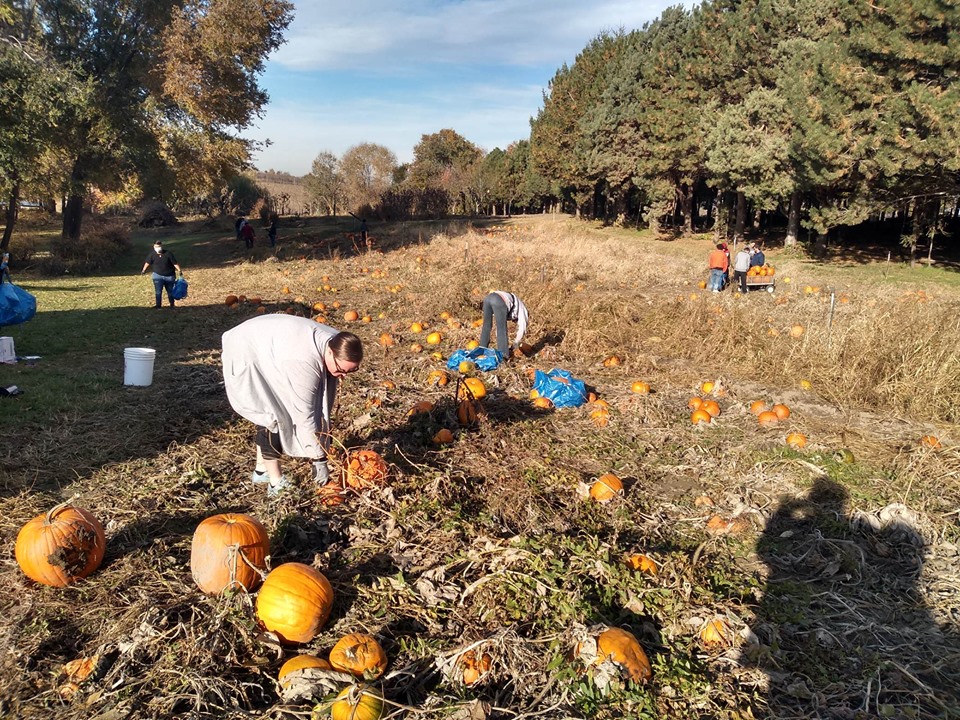
Volunteering: Literally Moving Mountains
13 Nov 2019, by Admin in Harvest Blog, Harvest VISTA, Gleaning, Washington state, Opportunities Industrialization Center (OIC)Harvest VISTA Gleaning Coordinator VISTA Mary Pearl Ivy serves at OIC of Washington, a non-profit organization providing community services through federal, state and local funding sources. Mary Pearl’s focus is with the Emergency Food Assistance Program (TEFAP), which aims to supplement the diets of low-income Americans including the elderly by providing them with food and nutrition assistance at no cost. In addition to farm to table communications for the food bank, Mary Pearl recruits volunteers to work within a community garden, in hopes of providing accessibility to knowledge and resources for individuals to grow their own fresh foods.
In today’s hunger-fighting coalitions our bulk of the action in food banks, gleaning teams, distribution centers, and soup kitchens, etc comes from our volunteers. At the OIC of Washington in Yakima, there are many types of volunteers and reasons they serve, but the underlying reason for service is understanding the struggle through experience and wanting to help out to end that struggle; having team members who understand living within food insecurity and utilizing food banks are the key to best-serving the community.
When the staff is faced with a problem often the answer is pulled from experience. Example: when we get brown bananas, usually not the easiest thing to give out, our volunteers get excited! The reason for this excitement is all the ingredients to make a delicious banana milkshake are cost-free at the bank. When the volunteers are working with clients they are excited to share what meals and treats can be made with what we have to offer, which can be practiced to better equip clients to use what they are given. Another example of this is when the banks get loads and loads of perishables, (ie apples, pumpkins, grapes, veggies), the volunteers always know what to do with them. Since reorganizing the fresh/healthier options to be placed in front of the less healthy options we have seen volunteers able to give away boxes upon boxes of produce, knowing that they can use it for apple sauce, pumpkin soup, or salads. When volunteers offer this information, listen and respond with flyers that support their recommendations you’ll be surprised how items will fly off the shelves.
Not only are knowledgeable volunteers important in the distribution of food but also the harvesting of it; which is crucial not only for the quality of the produce but for the relationship with the growers. Providing volunteers with training and educational materials to reference helps not only informs our volunteers how to properly collect produce, it also provides them with information on how to prepare even some of the more obscure foods we don’t necessarily eat every day. Pumpkins, for example, need to be harvested by cutting the stem and not ripping/holding the fruit by it; this preserves the pumpkin and prevents it from molding. Pumpkins have a great shelf life and many uses beyond jack-o-lanterns: roasted seeds; roasted pumpkin; curry; soup; and of course; pie. So when we harvested the seasonal staple with the help of Youth Build volunteers they were able to share not only the food itself but the information they learned with their families and community through the food bank. A mountain of 4,000 lbs of pumpkins were collected in just a couple of hours helping to feed and entertain roughly 400 families.
The knowledge and action that volunteers provide are undoubtedly one of the most valuable resources in the world. Erma Bombeck once wrote that “Volunteers are the only human beings on the face of the earth who reflect this nation’s compassion, unselfish caring, patience, and just plain loving one another.” The time, energy and knowledge that volunteers share every day with their community exhibit how powerful love for a community can be; it literally moves mountains.




